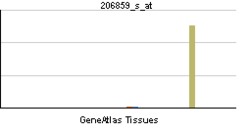- PAEP
-
Progestagen-associated endometrial protein Identifiers Symbols PAEP; GD; GdA; GdF; GdS; MGC138509; MGC142288; PAEG; PEP; PP14 External IDs OMIM: 173310 HomoloGene: 99710 GeneCards: PAEP Gene Gene Ontology Molecular function • transporter activity
• bindingCellular component • extracellular region Biological process • multicellular organismal development Sources: Amigo / QuickGO RNA expression pattern 
More reference expression data Orthologs Species Human Mouse Entrez 5047 n/a Ensembl ENSG00000122133 n/a UniProt P09466 n/a RefSeq (mRNA) NM_001018049.1 n/a RefSeq (protein) NP_001018059.1 n/a Location (UCSC) Chr 9:
138.45 – 138.46 Mbn/a PubMed search [1] n/a Glycodelin is a protein that in humans is encoded by the PAEP gene.[1][2][3]
This gene is a member of the kernel lipocalin superfamily whose members share relatively low sequence similarity but have highly conserved exon/intron structure and three-dimensional protein folding. Most lipocalins are clustered on the long arm of chromosome 9. The encoded glycoprotein has been previously referred to as pregnancy-associated endometrial alpha-2-globulin, placental protein 14, and glycodelin, but has been officially named progestagen-associated endometrial protein. Three distinct forms, with identical protein backbones but different glycosylation profiles, are found in amniotic fluid, follicular fluid and seminal plasma of the reproductive system. These glycoproteins have distinct and essential roles in regulating a uterine environment suitable for pregnancy and in the timing and occurrence of the appropriate sequence of events in the fertilization process. A number of alternatively spliced transcript variants have been observed at this locus, but the full-length nature of only two, each encoding the same protein, has been determined.[3]
References
- ^ Rutanen EM, Koistinen R, Seppala M, Julkunen M, Suikkari AM, Huhtala ML (Feb 1988). "Progesterone-associated proteins PP12 and PP14 in the human endometrium". J Steroid Biochem 27 (1–3): 25–31. doi:10.1016/0022-4731(87)90290-1. PMID 3320533.
- ^ Van Cong N, Vaisse C, Gross MS, Slim R, Milgrom E, Bernheim A (May 1991). "The human placental protein 14 (PP14) gene is localized on chromosome 9q34". Hum Genet 86 (5): 515–8. PMID 2016092.
- ^ a b "Entrez Gene: PAEP progestagen-associated endometrial protein (placental protein 14, pregnancy-associated endometrial alpha-2-globulin, alpha uterine protein)". http://www.ncbi.nlm.nih.gov/sites/entrez?Db=gene&Cmd=ShowDetailView&TermToSearch=5047.
Further reading
- Seppälä M, Bohn H, Tatarinov Y (1998). "Glycodelins". Tumour Biol. 19 (3): 213–20. doi:10.1159/000030009. PMID 9591048.
- Salier JP (2000). "Chromosomal location, exon/intron organization and evolution of lipocalin genes". Biochim. Biophys. Acta 1482 (1–2): 25–34. doi:10.1016/S0167-4838(00)00144-8. PMID 11058744.
- Halttunen M, Kämäräinen M, Koistinen H (2000). "Glycodelin: a reproduction-related lipocalin". Biochim. Biophys. Acta 1482 (1–2): 149–56. doi:10.1016/S0167-4838(00)00158-8. PMID 11058757.
- Seppälä M, Taylor RN, Koistinen H, et al. (2003). "Glycodelin: a major lipocalin protein of the reproductive axis with diverse actions in cell recognition and differentiation". Endocr. Rev. 23 (4): 401–30. doi:10.1210/er.2001-0026. PMID 12202458.
- Seppälä M, Koistinen H, Koistinen R, et al. (2007). "Glycosylation related actions of glycodelin: gamete, cumulus cell, immune cell and clinical associations". Hum. Reprod. Update 13 (3): 275–87. doi:10.1093/humupd/dmm004. PMID 17329396.
- Garde J, Bell SC, Eperon IC (1991). "Multiple forms of mRNA encoding human pregnancy-associated endometrial alpha 2-globulin, a beta-lactoglobulin homologue". Proc. Natl. Acad. Sci. U.S.A. 88 (6): 2456–60. doi:10.1073/pnas.88.6.2456. PMC 51251. PMID 2006183. http://www.pubmedcentral.nih.gov/articlerender.fcgi?tool=pmcentrez&artid=51251.
- Wood PL, Iffland CA, Allen E, et al. (1990). "Serum levels of pregnancy-associated endometrial alpha 2-globulin (alpha 2-PEG), a glycosylated beta-lactoglobulin homologue, in successful and unsuccessful assisted conception". Hum. Reprod. 5 (4): 421–6. PMID 2113930.
- Vaisse C, Atger M, Potier B, Milgrom E (1990). "Human placental protein 14 gene: sequence and characterization of a short duplication". DNA Cell Biol. 9 (6): 401–13. doi:10.1089/dna.1990.9.401. PMID 2206398.
- Check JH, Nowroozi K, Chase JS, et al. (1990). "Serum progestagen-associated endometrial protein (PEP) levels in conception versus nonconception cycles following in vitro fertilization-embryo transfer". Journal of in vitro fertilization and embryo transfer : IVF 7 (3): 134–6. doi:10.1007/BF01135675. PMID 2380618.
- Wood PL, Waites GT, MacVicar J, et al. (1989). "Immunohistological localization of pregnancy-associated endometrial alpha 2-globulin (alpha 2-PEG) in endometrial adenocarcinoma and effect of medroxyprogesterone acetate". British journal of obstetrics and gynaecology 95 (12): 1292–8. PMID 2975952.
- Joshi SG (1988). "Progestin-dependent human endometrial protein: a marker for monitoring human endometrial function". Adv. Exp. Med. Biol. 230: 167–86. PMID 3135704.
- Julkunen M, Seppälä M, Jänne OA (1988). "Complete amino acid sequence of human placental protein 14: a progesterone-regulated uterine protein homologous to beta-lactoglobulins". Proc. Natl. Acad. Sci. U.S.A. 85 (23): 8845–9. doi:10.1073/pnas.85.23.8845. PMC 282603. PMID 3194393. http://www.pubmedcentral.nih.gov/articlerender.fcgi?tool=pmcentrez&artid=282603.
- Huhtala ML, Seppälä M, Närvänen A, et al. (1987). "Amino acid sequence homology between human placental protein 14 and beta-lactoglobulins from various species". Endocrinology 120 (6): 2620–2. doi:10.1210/endo-120-6-2620. PMID 3569148.
- Bell SC, Keyte JW, Waites GT (1987). "Pregnancy-associated endometrial alpha 2-globulin, the major secretory protein of the luteal phase and first trimester pregnancy endometrium, is not glycosylated prolactin but related to beta-lactoglobulins". J. Clin. Endocrinol. Metab. 65 (5): 1067–71. doi:10.1210/jcem-65-5-1067. PMID 3667877.
- Bell SC, Hales MW, Patel SR, et al. (1986). "Amniotic fluid concentrations of secreted pregnancy-associated endometrial alpha 1- and alpha 2-globulins (alpha 1- and alpha 2-PEG)". British journal of obstetrics and gynaecology 93 (9): 909–15. doi:10.1111/j.1471-0528.1986.tb08007.x. PMID 3768286.
- Joshi SG, Smith RA, Stokes DK (1981). "A progestagen-dependent endometrial protein in human amniotic fluid". J. Reprod. Fertil. 60 (2): 317–21. PMID 6776278.
- Horne CH, Paterson WF, Sutcliffe RG (1982). "Localization of alpha-uterine protein in human endometrium". J. Reprod. Fertil. 65 (2): 447–50. doi:10.1530/jrf.0.0650447. PMID 7047733.
Categories:- Human proteins
- Chromosome 9 gene stubs
Wikimedia Foundation. 2010.
